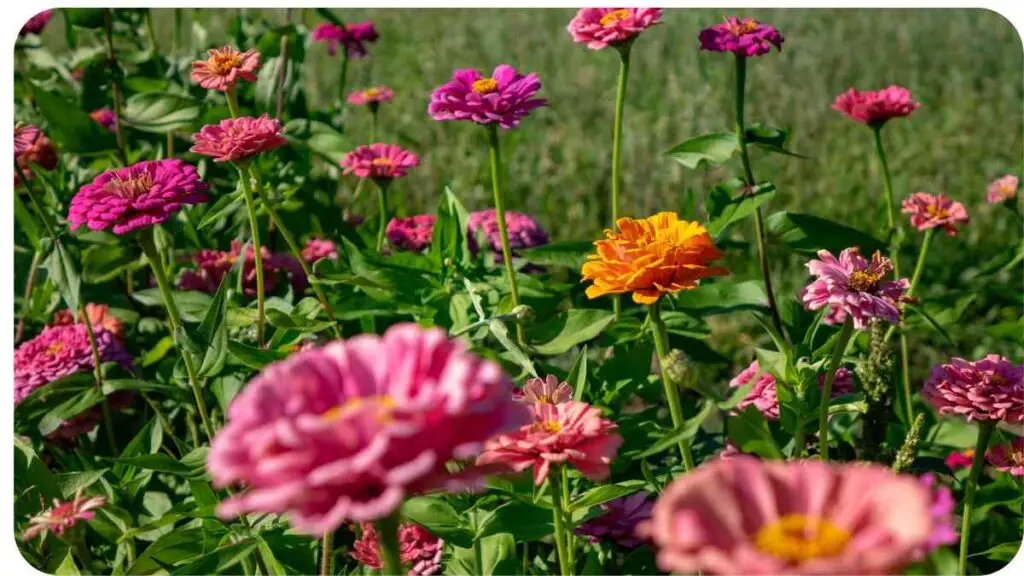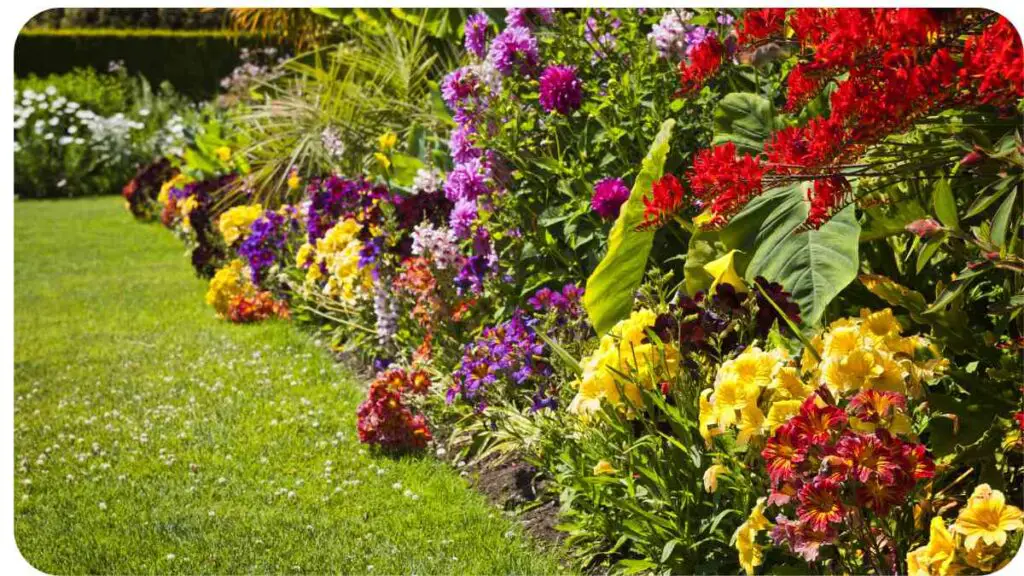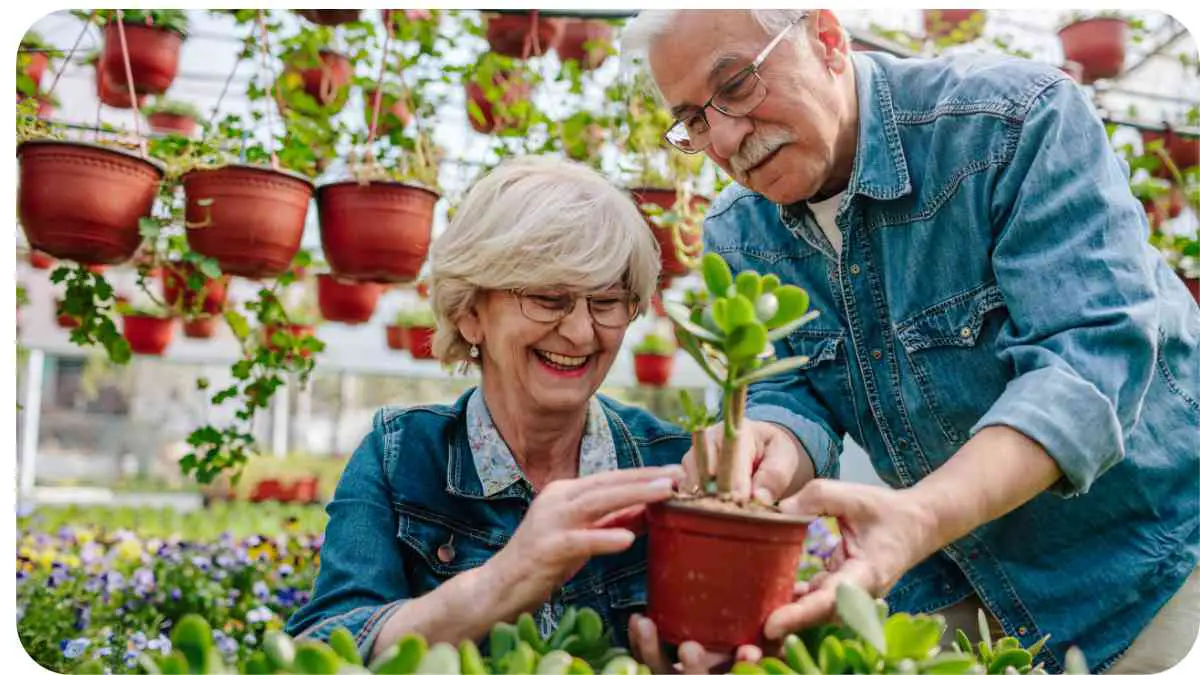Gardening is a fulfilling journey that should bring joy, not stress. This guide ensures your gardening experience is not only enjoyable but also sustainable.
Discover the keys to successful gardening, from planning and plant selection to maintaining a vibrant, eco-friendly space. Let’s transform your garden into a haven of beauty and tranquility.
| TAKEAWAYS |
|---|
| Plan your garden properly |
| Choose the right plants for your location |
| Invest in high-quality gardening tools |
| Learn proper watering techniques |
| Stay on top of garden maintenance |
| Don’t be afraid to ask for help or advice |
| Enjoy the gardening process and have fun! |
Optimize Your Garden Layout for Wellness and Beauty

As we’ve explored, plants play a vital role in enhancing both physical health and overall well-being. Now, let’s delve into creative ways to incorporate them into your life. If you’re blessed with a spacious plot of land, consider crafting a year-round haven through gardening.
For those not inclined towards formal plots, an alternative awaits – the herb garden. Whether nestled indoors or adorning your patio, herb gardens are versatile, serving as both culinary delights and meditation havens. Unleash your creativity to design a garden layout that not only nourishes the body but also soothes the soul.
To improve your gardening skills, it’s important to learn from the experts and follow their tips. Check out our article on how to not suck at gardening for some helpful advice from experienced gardeners.
Cultivate Your Garden Journal: A Chronicle of Growth and Wisdom
Write down the date and weather conditions.
Embark on the journey of documenting your gardening endeavors with a dedicated journal. Here’s a comprehensive guide to creating and maintaining a fruitful garden log:
- Record the Essentials: Note the date and prevailing weather conditions to track seasonal trends and their impact on your garden’s progress.
- Planting Details: Document what you plant, including the variety, quantity, and planting dates. Keep a record of when you started each plant, aiding in gauging growth patterns and timelines.
- Harvest Chronicles: Log your harvest yields, noting the quantity and quality of produce from each plant. Identify any standout performers and areas for improvement.
- Troubleshooting Insights: Document challenges encountered during the growing process, such as diseases, infestations, or harvesting difficulties. This insight informs future strategies and preventative measures.
- Seek Wisdom: Reach out to experienced gardeners in your community for valuable advice and insights. Learn from their expertise to refine your gardening techniques and enhance future yields.
Top Tips for Starting a Garden Journal
| Tip | Description |
|---|---|
| Set goals | Determine what you want to get out of your garden journal, such as tracking plant growth or recording gardening techniques. |
| Choose a format | Decide on the format of your journal, such as a physical notebook, digital spreadsheet, or gardening app. |
| Record information consistently | Set a schedule for recording information in your journal, such as once a week or once a month, and stick to it. |
| Include important details | Include information such as plant names, planting dates, weather conditions, and any treatments or fertilizers used. |
| Take pictures | Photograph your plants and garden regularly to compare growth over time. |
| Reflect on your progress | Take time to reflect on what you’ve learned and how you can improve your gardening skills in the future. |
| Have fun with it | Remember that gardening is meant to be enjoyable, so don’t stress too much about keeping a perfect journal. |
Harvesting Wisdom: A Beginner’s Guide to Seeking Gardening Advice
Embarking on your gardening journey? Harness the wealth of knowledge from seasoned gardeners to ensure success. Here’s how to seek valuable advice:
- Community Connections: Tap into the experience of your local community. Connect with neighbors, family members, or friends who boast a green thumb. Their firsthand insights can be invaluable for a gardening novice.
- Online Gardening Networks: Dive into the vast world of online gardening communities. Social media platforms like Facebook host dedicated groups and forums where seasoned gardeners readily share their expertise. Pose questions, share experiences, and cultivate a virtual garden of collective wisdom.
- Local Garden Centers: Explore your neighborhood garden centers or nurseries. These establishments are treasure troves of botanical knowledge. Seek guidance on plant selection, care tips, and tailored advice based on your local climate.
As a gardener, having the right tools can make all the difference in the world. Check out our guide on what are the tools of gardening to learn about the essential supplies and equipment every gardener needs to have on hand.
Blooms of Beauty: A Guide to Selecting Flowers for Your Garden

Elevate your garden’s aesthetics by choosing the perfect flowers that align with your aspirations and commitment. Here’s a tailored approach to selecting flowers based on your preferences and gardening style:
- Quick Splashes of Color: If you seek an instant burst of vibrancy without extensive commitment, opt for annuals or biennials. These plants, sown from seed each year, offer a swift and easy solution. Plant them in the spring or fall, taking advantage of warm but not scorching soil conditions. Watch them flourish before gracefully bowing out in winter.
- Year-Round Elegance: For those with more time and patience, or a desire for lasting beauty, perennials are the answer. Plant them during spring or summer, ensuring frost-free conditions. Perennials, while requiring consistent watering throughout their growth period, reward you with enduring blooms. Consult with an experienced gardener for proper pruning techniques at the season’s end.
Cultivate Flavor and Health: Growing Your Own Vegetables and Herbs
Unlock the joys of homegrown produce by mastering the art of cultivating vegetables and herbs. Here’s how to transform your space into a thriving culinary oasis:
- Space-Savvy Planting: Embrace the versatility of container gardening. Whether it’s your patio, balcony, or front steps, utilize containers and pots to maximize your growing potential. Even small garden beds outside your kitchen door can yield bountiful harvests.
- Herbal Havens: Harness the power of herbs to elevate your culinary creations and enhance your outdoor ambiance. Plant basil to not only flavor your salads and soups but also ward off mosquitoes during backyard gatherings. Add parsley for its vibrant hues and versatile flavor profile, enriching a myriad of dishes.
- Tomato Triumphs: Delve into the world of tomato cultivation, a rewarding endeavor that promises juicy rewards. Easily grown from seedlings, tomatoes thrive in containers or garden beds. Harvest the ripe fruits for vibrant salsas or relish them fresh off the vine, paired perfectly with a sprinkle of Romano cheese.
Looking to get started with gardening but don’t know where to begin? Our easy guide on how can I get into gardening can help! From finding the right plants to starting a garden bed, this guide covers everything you need to know to get started.
Cultivating Black Gold: A Beginner’s Guide to Composting
Delve into the world of composting, where organic materials transform into nutrient-rich gold for your garden. Here’s your step-by-step guide to starting and maintaining a successful compost pile:
- Composting Unveiled: Composting is a natural process that breaks down organic materials like food scraps and leaves into a nutrient-rich substance known as compost. This valuable resource serves as an eco-friendly fertilizer for your plants.
- The Microbial Magic: Microorganisms play a crucial role in composting, generating heat that aids in the breakdown of materials. However, some microorganisms may harm your plants, so it’s essential to keep the compost away from the garden until decomposition is complete.
- Compost Bin Basics: Invest in a compost bin designed for easy access. This ensures a convenient way to collect nutrient-rich compost whenever your plants crave a boost.
- Starting Your Compost Heap: Choose an ideal location for your compost heap, ideally a sunny spot sheltered from harsh weather conditions. Maintain temperatures between 40°F (4°C) at night and daytime highs of 70°F (21°C).
- Essential Ingredients: Gather kindling wood (twigs or small branches) for aeration, nitrogen-rich materials (fresh grass clippings), and carbon-rich materials (old newspapers or cardboard) to strike the perfect compost balance.
- The Right Mix: Layer your compost materials, alternating between green (nitrogen-rich) and brown (carbon-rich) components. Ensure proper aeration by turning the pile regularly.
- Maintain Moisture: Keep your compost moist but not waterlogged. Adequate moisture supports the microbial activity necessary for decomposition.
- Personal Protection: Consider wearing gloves for hygiene and protection while handling compost materials.
Top Tips for Starting a Compost Pile
| Tip | Description |
|---|---|
| Choose a location | Find a suitable location for your compost pile, such as a corner of your yard or garden area. |
| Decide on a compost bin | Decide whether you want to use a store-bought compost bin or make your own using materials like chicken wire or pallets. |
| Choose your materials | Collect compostable materials such as kitchen scraps, yard waste, and shredded paper. Avoid adding meat, dairy, or oily foods. |
| Mix materials | Layer the materials in your compost bin, alternating between green materials (like food scraps and grass clippings) and brown materials (like leaves and paper). |
| Keep it moist | Keep your compost moist but not waterlogged, and turn the pile regularly to help with aeration. |
| Be patient | Composting takes time, so be patient and give the materials time to break down. |
| Use your compost | Once your compost is dark, crumbly, and free of recognizable materials, it’s ready to use in your garden as a natural fertilizer. |
Green Living: Composting Household Waste Without the Ick Factor
Transform your kitchen scraps into a valuable resource by embracing household composting. Here’s a user-friendly guide to reduce waste and create nutrient-rich fertilizer, minus the “gross” factor:
- Waste Reduction Magic: Composting is an eco-friendly solution to minimize household waste, especially those forgotten vegetables in the fridge. Embrace this sustainable practice to turn food scraps into garden gold.
- Versatile Composting Spaces: Whether you have a backyard or a balcony in your apartment building, composting can adapt to your living situation. Some apartments even provide compost bins for residents, making it accessible for urban dwellers.
- Decomposition Dance: Composting involves a simple yet effective process—mixing food scraps with water. Allow this mixture to decompose over time, transforming into a dark, crumbly substance ready to enrich your garden soil.
- Balcony Composting Hack: Lack yard space? No worries! Craft your own compost bin using a plastic tub or garbage can. Ensure proper aeration and turn your balcony into a mini composting haven.
Gardening can be tough on your hands, which is why it’s important to wear the right gloves. Check out our article on what kind of gloves are good for gardening to learn about the different types of gloves available and which ones are best suited for your gardening needs.
Feathered Haven: Crafting a Bird-Friendly Garden Sanctuary

Elevate your garden into a haven for our avian friends by creating a bird habitat. Follow these steps to ensure a welcoming space that attracts and sustains a variety of bird species:
- Strategic Bird Feeders: If you have a bird feeder, strategically place it in an easily accessible location. Ensure birds can reach it effortlessly, promoting frequent visits. A thoughtfully positioned feeder becomes a bustling dining spot for your feathered guests.
- Botanical Allure: Plant trees and shrubs known for their appeal to birds. These green additions not only enhance the aesthetics of your garden but also provide shelter and nesting spots, encouraging birds to make your space their home.
- Refreshing Bird Baths: Integrate a bird bath into your garden design. This simple addition offers a vital water source for birds, especially during warmer days when hydration is crucial. Maintain the bird bath regularly to keep water clean and inviting.
- Hydration Stations: During hot days, ensure a steady water source for birds to stay hydrated. This thoughtful provision supports their well-being and promotes a thriving bird population in your garden.
- Pesticide-Free Zone: When cultivating your bird-friendly habitat, refrain from using pesticides. These chemicals can harm birds and disrupt the delicate balance of the ecosystem you’re creating. Opt for natural alternatives to protect both your garden and its feathered inhabitants.
Elevate Your Garden: Mastering Vertical Gardening for Limited Spaces
Transform your outdoor space into a lush and productive haven by embracing the art of vertical gardening. Whether you have a small urban garden or a sprawling landscape, vertical gardening is a versatile technique that optimizes space utilization. Here’s how to make the most of your vertical canvas:
- Versatility in Size: Vertical gardening is a boon for small gardens, but its benefits extend to larger spaces as well. The technique adapts to the scale of your garden, providing a space-efficient solution for every outdoor oasis.
- Utilize Supports: Employ supports like trellises and fences to embark on vertical growing adventures. These structures not only offer stability for plants that require support but also serve as innovative canvases for a creative green display.
- Diverse Plant Palette: Explore the vast array of plants suitable for vertical growth. From fruit trees to vegetables and herbs, vertical gardening broadens your plant palette, allowing you to cultivate a diverse and visually appealing garden.
- Maximize Limited Space: The beauty of vertical gardening lies in its ability to maximize space. By growing plants vertically, you can overcome spatial limitations, ensuring that even confined areas become flourishing landscapes.
- Creative Planting Techniques: Experiment with planting on the sides of structures rather than in traditional upright positions. This creative approach not only adds an artistic touch to your garden but also expands your planting possibilities.
Gardening can be a fun and rewarding hobby, but it’s important to understand the costs involved before you get started. Check out our guide on how much does gardening cost to learn about the expenses associated with starting and maintaining a garden, and how to budget accordingly.
Harvest at Your Doorstep: Growing Fruits and Berries in Pots or Beds
Embark on a delicious journey of homegrown goodness by cultivating your own potted fruit and berry garden. Whether you have limited space in an apartment or a sprawling outdoor area, growing in pots or beds offers a convenient and rewarding gardening experience. Here’s how to get started:
- Space-Savvy Potted Gardening: Opt for potted fruit and berry plants for an accessible and manageable gardening endeavor. Perfect for apartments or patios, these potted gems are not only easy to maintain but also add a touch of beauty to your living space.
- Outdoor Bed Bliss: Alternatively, plant your fruits and berries in outdoor beds. This approach allows for larger yields and is suitable for various climates. Choose a sunny spot with well-draining soil for optimal results.
- Potted Elegance: Potted fruit trees, in particular, serve as both functional and decorative elements. Their beauty enhances your surroundings while providing a bounty of delicious, homegrown fruits that surpass store-bought varieties in flavor and freshness.
- Simplicity in Gardening: Gardening need not be complicated. Potted plants offer a hassle-free alternative, perfect for those who prefer simplicity over the upkeep of expansive lawns and shrubs. Enjoy the benefits of fresh fruits and berries without the stress of elaborate garden maintenance.
- Indoor or Outdoor Flexibility: Potted plants offer the flexibility to be grown indoors or outdoors, catering to your local climate. Enjoy a year-round harvest, regardless of the external weather conditions.
Gardening Success Starts with the Right Tools: A Beginner’s Guide
Embarking on your gardening journey requires the right set of tools to cultivate a thriving green space. If you’re new to gardening or exploring your gardening style, consider starting with this essential toolkit:
- Hand Trowel: A versatile and indispensable tool for planting, transplanting, and digging in smaller spaces. The hand trowel is your go-to companion for various gardening tasks, from potting plants to cultivating soil.
- Spade/Shovel (Hand or Motorized): Choose a spade or shovel based on your gardening needs. Whether you opt for the efficiency of a motorized version or the simplicity of a hand tool, a spade or shovel is essential for tasks like digging and turning soil.
- Hoe or Mattock (Hand or Motorized): The hoe or mattock comes in handy for breaking up soil, weeding, and cultivating. Determine the size and type based on your gardening scale, whether it’s a compact hand tool or a motorized version for larger areas.
- Rakes (Large and Small): Rakes are indispensable for smoothing soil, removing debris, and leveling surfaces. Have both large and small rakes in your toolkit to tackle a variety of tasks efficiently.
Conclusion
In conclusion, gardening offers not only a means of nurturing plants but also a pathway to enriching our lives. Through the tips and insights shared in this guide, we’ve uncovered the myriad joys and benefits that gardening brings whether it’s fostering a deeper connection with nature, cultivating fresh and nutritious produce, or creating a serene sanctuary right in our own backyard.
As we navigate the intricate tapestry of gardening, let us remember that it is not solely about the fruits of our labor, but also about the journey itself—the moments of awe as seeds sprout, the satisfaction of tending to flourishing blooms, and the camaraderie found in sharing experiences with fellow gardeners.
May this guide serve as a source of inspiration and empowerment as you embark on your gardening endeavors. Embrace the learning curve, celebrate the successes, and remain resilient in the face of challenges. Above all, cherish the opportunity to cultivate beauty, foster growth, and sow seeds of positivity in the world around you.
With dedication, creativity, and a nurturing spirit, may your garden flourish and thrive, reflecting the beauty and abundance of the natural world. Happy gardening, and may your green thumb continue to bloom with each passing season.
Further Reading
Check out this article from Love Your Landscape on top tips for gardening like a pro.
Self has compiled 23 gardening tips that will help you plant like a pro.
Check out this guide from Miracle-Gro on 10 top gardening tips for beginners that will help you start your garden off on the right foot.
FAQs
What are some common mistakes that beginner gardeners make?
Some common mistakes that beginner gardeners make include overwatering or underwatering their plants, planting them in the wrong location for the amount of sunlight they need, and not preparing the soil properly before planting.
How do I know which plants are best suited for my garden?
Before deciding on which plants to include in your garden, it’s important to consider the amount of sunlight, water, and soil type that is available in your particular location. Research which plants are best suited for the climate and soil conditions in your area.
What is the best time of year to start a garden?
The best time to start a garden will depend on the climate and location of your garden. However, in general, it’s a good idea to start planting in the spring after the last frost date has passed.
How often should I water my plants?
The amount of water your plants need will depend on a variety of factors, such as the type of plant, the soil type, and the climate. In general, it’s best to water deeply and infrequently rather than shallowly and frequently. Aim to keep the soil consistently moist but not waterlogged.
What are some tips for maintaining a healthy garden?
To maintain a healthy garden, it’s important to regularly weed the area, prune trees and plants as needed, and fertilize the soil. Additionally, it’s important to regularly check for and treat any pests or diseases that may be affecting your plants.

Hi! My name is Hellen James, and I’m here to help you with your home-maintenance needs. Whether it’s building a better yard or just trying to fix a garden—I can show you how.


